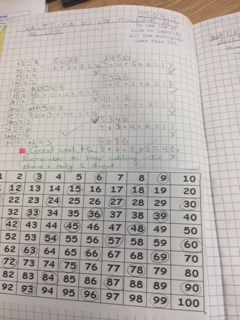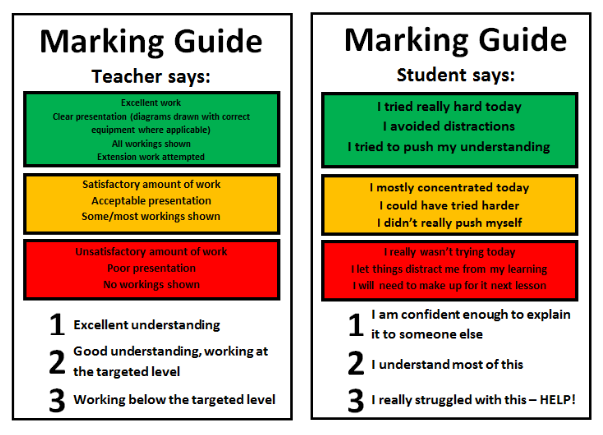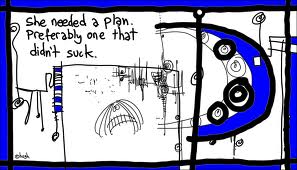This post has come about further to me making improvements in my own teaching practice. Do not expect an exhaustive list of approaches that you can try; that is not what this post is about. This is a reflection of an ongoing piece of work that can be applied to any subject area but here it has been done with reference to Mathematics.
The project that got me thinking
As part of my role as a Specialist Leader in Education (SLE), I had the opportunity to work with other teachers (Primary & secondary) on a Mathematics project. The aim of the project was to identify ways in which we (Maths teachers) could support students in the transition from Primary to Secondary; a difficult stage for many. We met, we talked and we shared our thoughts on how best to support students through this transition. Over the course of six months, our focus shifted more and more towards book work. There was something happening with the students work between the time they left primary and the few months later when they joined their secondary schools. Some students, whose work was always very tidy, suddenly lost that beautiful presentation, the layout became odd and at times, the Mathematics presented to teachers was “mathematically incorrect” (Prof. Ros Sutherland University of Bristol).
An aspect of the project involved all of us pairing up and visiting each others school to observe teaching, to speak with students and to look at books. As I teach in a secondary school and all of the support that I provide as an SLE is with secondary schools, I was paired with a primary school and it was a fantastic experience (Knowle Park Primary School – this is content enough for another blog so I shall not digress!).

The students’ books certainly had an impact on me. The majority were consistently tidy, there was formative feedback, students had assessed their own work, it was well presented and (…wait for it…) the work had been marked regularly; on a daily basis. This immediately got me thinking ‘when did these teachers find the time to mark each book, every single day?‘ and then I thought ‘why can’t we do this at secondary schools? what is the limiting factor? is there a limiting factor?‘
How often do you mark your books?
Okay, I’m going to take a step back for a moment. I’ve been teaching for few years now and have seen different ways of marking applied to students’ work. Furthermore, there is little sympathy for Maths teachers if they dare moan about marking. I’ve heard many a teacher say;
Oh you’ve got it easy. It’s just a case of ticking the answer to let them know if it’s right or wrong. It’s just numbers and there’s not really much to mark, is there?!
(If you do not teach Maths, please go and have a look at the books of students in your Maths colleagues’ classrooms…you may well be surprised).
Up until last year, I used to work in a school where students checked their own answers (or completed peer assessment) each lesson as there was a ‘no marking policy’ for students books; this was and still is an Outstanding school. In contrast, I now work at a school where there is a marking policy and the frequency of marking varies from subject to subject (and most likely from teacher to teacher).
I should have been providing formative feedback when marking and this should have been happening bi-weekly. My students knew this, I knew this, my Head of Department (HoD) knew this and the Senior Leadership Team (SLT) who would routinely conduct a book scrutiny, certainly knew this. The majority of staff in the Maths department could do this, so why couldn’t I keep up? Why was I the black sheep of the Maths department? (no pun intended. If you’re reading this you’ve obviously seen my profile picture) Was it due to the fact that for years I didn’t have to do this style of marking? Was it down to having a particularly heavy workload with me taking on two new roles and moving to a new school all at the same time?
I’m still not entirely sure why I couldn’t mark books effectively but a combination of the above and my dislike of marking, certainly hindered my progress in this aspect of my teaching practice. Things got bad when I had two students from my year 9 class ask me when I was going to mark their books. Then I felt doubly awful because students in my year 10 class asked what I thought of a particular piece of work they had completed in their books; I later saw that it was amazing, it was a week old and I hadn’t even seen the results of their hard work in their books! I felt like a bad mum to my little ones
I didn’t like this and having been a student myself (some time ago), I know I would not have accepted this; something had to change.
How do you mark your books?
I spoke to other members of the Maths department to identify what they were doing and how long it took. I even spoke to teachers out of my department to see if there was anything that they were doing that I could apply to my marking – nothing different here.
It took me a long time and a lot of messing about but I tried a few things;
- Marking in green pen – a big no, no. Students use green pens to respond to your comments; use red.
- White feedback sheets – This was no good as students wouldn’t always notice the sheets in their books and as such were not spending any time reading formative feedback nor assessing their work.
- Yellow or Green feedback sheet – better because students could see them and no that they had to respond/assess their work.
- P+ P- Px – improved the presentation of the work but content was really being marked.
- RAG123 – The usual Red, Amber, Green rating which is quick to do.
What next?
Taking this a step further I looked over some of my books for inspiration. The Lazy Teachers Handbook by Jim Smith has an entire chapter dedicated to marking (Marking RIP! The Lazy Teacher Shows you How) and reminded me of some basics but these were things that I was already doing and some were taking ages. e.g. planning appropriate work for marking, being consistent, using symbols, getting students to peer assess first and so on.
Inside the black box by Black & Wiliam looks at formative assessment and although seemingly obvious, it clarified my thinking on marking and got me headed in the right direction;
Feedback to any pupil should be about the particular qualities of his or her work, with advice on what he or she can do to improve and should avoid comparisons with other pupils
Furthermore, so that assessment is meaningful to the student and productive, they state that;
…pupils should be trained in self-assessment so that they can understand the main purposes of their learning and thereby grasp what they need to do to achieve.
This training to which Black & Wiliam refer, is that consistency of approach, not continually trying new things with a class (I am guilty of this!). Students, (like so many teachers who are not leading lessons in mathematics) assume as I said earlier, that marking in Maths is a case of a tick here and a cross there and that’s it. If it was that simple, how could students learn to improve upon what they have already done? If the answer is wrong and there is only a cross on the page to signify the error, that student may not spot where they have made a mistake. As such, the formative dialogue is still required and I would argue that the increased frequency of this dialogue, gives us Maths teachers a better chance of identifying misconceptions and getting students out of bad habits quickly.
So what have I done? What’s working for me?
The solution for me and my classes is a combination of a formative feedback sheet and the RAG123 rating (Red, Amber, Green 1, 2, 3); thanks @listerkev. Full details of how to use #RAG123 can be found here and a video showing RAG123 in action can be viewed here.
At the end of each lesson (no more than 2-3 minutes), each student looks at their work and decides what their rating was for the lesson using the criteria below:

e.g. G1 – I tried really hard today and I am confident enough to explain it to someone else; G3 – I tried really hard today and I really struggled with this – HELP!; R2 – I wasn’t really trying today but I understand most of this…and so on.
Encouraging students to leave comments with their ratings is tricky with some classes however, some have taken to doing this. They seem to be more comfortable doing this as they know that feedback is pretty much unique for each of them. It is a perfect approach to marking for me, as I can see what my students have done, I can help students better understand any areas that they ‘didn’t get‘ in class and direct them to the correct level of work for the next lesson. Subsequently, this approach better informs my planning as I am aware of when to move on, extend time on a topic or try a different method.
There are a considerable number of examples of this style of marking on the internet (do a quick search or click here for results on Twitter). Here are a few examples of the quick RAG123 marking (I will add further photographs of my students work on my return to school in term 6).
In conclusion…a work in progress
To conclude, I have to say that I am a happy bunny. I am able to sit down at the end of each day and mark the books of every student that I have taught. My students are happy with the way I am marking their books and they are pleased with the regularity.
I was dubious at the start of this little experiment because I thought students might over/under estimate their level of understanding. Furthermore, I thought they were all going to put ‘Green’ for effort but I am pleased to say that my students have been honest and are getting better at effectively assessing work. It has certainly helped with the presentation of the work and the concentration (and behaviour) of some students – they know I will see their work in detail later that day.
This may sound very cheesy but I am proud of the turn around I have made in this part of my teaching practice and I am very proud of the improvements that I have seen in my students work…











